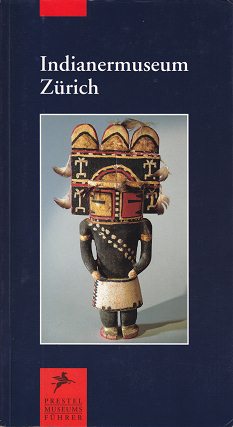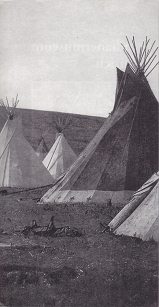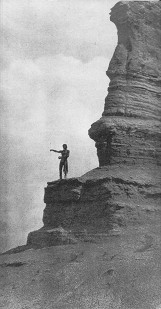from:
Prestel museum guide, text by Denise Daenzer and Tina
Wodiunig: Native Museum of Zurich (orig. German:
Indianermuseum Zürich / Indianermuseum der Stadt Zürich);
Prestel edition; Munich, New York 1996; supported by
Cassinelli Vogel foundation, Zurich, by MIGROS percent for
culture, by Volkart foundation in Winterthur; ISBN
3-7913-1635-4
Comment
In this museum about primary nations in Zurich we can see a
little bit of how rich culture of primary nations was, and
what is missing in today's civilization: There is missing
the relation to Mother Earth, to harmony of the elements and
to the Great Spirit. Topics are the paintings of Karl
Bodmer, some clothes, quillwork and beading, feathers,
jewelry, plaitwork, pottery, horn carving, wood carving,
figurines, and tobacco smoking and pipes. Other topics like
natural medicine, adoration rituals and the relationship to
other worlds will be found in other literature for sure.
Michael Palomino, 6 June 2012


Cover
of the museum guide with a Sio Hemis Kachina
[Authors]
Denise Daenzer (1947), lic. phil., studied ethnology and
pedagogy in Zurich and is teacher at Zurich professional
schools; also working in exhibitions. Now lecturer at
Higher School of Arts in Zurich, since 1993 leading woman
conservator of Native Museum in Zurich. Member of Swiss
Ethnological Museum's Committee.
Tina Wodiuning (1960), lic. phil, studies ethnology,
sinology and psychology in Zurich. Several years working
as a basic school teacher, then active in field research
in South West Chinese Yunnan province about the topic of
ethnic identity. Today scientific co-worker and deputy
director of Native Museum in Zurich. Member of
administrative board of EDAI (Economic Development for
Amerindians). (p.96)
[General warning: don't
romanticize natives]
Normal idea in the country of the natives is yet a
romantic and heroic one, eliminating truth from the scene.
There is the impression that the natives and their
cultures would not exist any more, as if all would be
past, legends for cinema, material for the museum. But
almost every day are news of new native fights , of their
loss of living space, of their property and character. But
despite of all some are not changing their romanticizing
ideas of a perfect native world not considering uranium
mines or McDonald's and Coca-Cola, not considering
alcoholism or unemployment. But the idea of a pure
native's nature and native's culture without
contradictions is a dream, a fiction never corresponding
to the truth - not in times of Sitting Bull and not at all
in today's times.
Zurich Native Museum wants to give a contribution
correcting these fixed ideas. Museum's program is not
another show with tomahawks, tipis, wigwams and scalps
with feathers with peace pipes, but watching without
conditions native cultures, soft approach to their
culture, to their myths and visions, to their history and
present.

 Tipi
tents of primary nations (natives, "Indians") Tipi
tents of primary nations (natives, "Indians")
|

 Offering
in Pueblo native culture ("Indians") Offering
in Pueblo native culture ("Indians")
|
Watching such photos with "still lives" one
should not think in romanticism. In these
cultures also was robbery, blood revenge, murder
by honor etc.
|
[Presentation of
action of life]
Such a museum's and exhibition work does not present the
objects isolated any more but is describing the individual
and action in life in common, the development processes
between tradition and changes, between adaption and
resistance. There is not the question finding of general
response, but above all should be put questions - critical
and self critical ones. Present museums (and future
museums) should be a window and a mirror at the same time,
should open the view to outside and inside, should invite
for a visit: visiting the world with others and foreign
people - and also visiting the own person, the own soul of
oneself.
The collection of Native Museum in Zurich consists of
about 2,000 objects and a precious collection of colored
engravings of famous Zurich native painter Karl Bodmer.
Add to this there is a representative specialized library
open for study's purposes.
[Beginning of the museum
in Zurich Aussersihl 1963 (a district with Sihl river)]
First there was a private collection of Zurich teacher's
couple Martha and Gottfried Hotz. This collection was
presented in 1961 first in Museum of Arts of Zurich with
the title "From tipi and wigwam - natives of North
America" (orig. German: "Aus Zelt und Wigwam - Indianer
Nordamerikas"). After Berlin Museum of Cultures wanted to
purchase the whole collection, Jakob R. Welti, editor of
"New Zurich News" ("Neue Zürcher Zeitung") was making
propaganda that Zurich should purchase these interesting
objects and succeeded, so local parliaments agreed
purchasing this collection. After that this "Hotz
collection" was first in a deposit and then three class
rooms in Feldstrasse school were arranged as provisional
museum exhibition rooms and in February 1963 "Native
Museum of Zurich" was opened under leadership of Gottfried
Hotz. In 1977 he resigned and Hans Läng was designated as
his successor - and he enlarged the collection with his
wife and (p.4) was above all engaged in publishing and as
a mediator between native cultures also gaining an
international reputation.
[Discussions about sense
and purpose of exhibitions]
After age-related resigning of Hans Läng in April 1993
museum's work was newly orientated not only showing
changing objects of the collection but also presenting
topics and texts within and outside the museum. So, there
was an exhibition "Exchange or sellout?" (orig. German:
"Austausch oder Ausverkauf?" showing some critical aspects
in the relationship with native past and present with
topics like "native tourism" and international art's
commerce, as also the role of museums as a whole
possessing a part of the native's heritage which not is
absolutely their right to have it. In another exhibition
with the title "Between demand and reality" (orig. German
"Zwischen Anspruch und Wirklichkeit" the difference
between native's being and "seem to be" was presented in
an always more and more americanized world and also
presenting the change of the personal identity of old and
young natives.
[Native museums outside
of "America" - or "America" sections in ethnological
museums]
Well, Native museum in Zurich is a little museum, but it
has got it's significance for whole Switzerland and even
for Europe: thanks of this collection which has got a very
good quality and thanks to it's originality. There is
another native museum in Radebeul in Dresden region, and
these two are the only ones only dedicating with North
American culture objects recollecting, conserving and
mediating them. There are other collections about America
in the great European ethnological museums but regularly
only have a limited access.
[Museum's events]
The only bewaring of the objects had to be overcome and a
kind of open forum for visits had to be created. Therefore
Native Museum of Zurich organized events and series of
events again and again presenting different topics and
sections, lectures, workshops and talks, courses and film
presentations, literature reading events and concerts, and
also daily and holiday courses - also for children, pupils
and youths. Add to this there is an offer for well guided
group trips visiting natives and their cultures on old and
new traces - by a simple, personal way.
[Museum's shop with
direct selling without intermediary trade]
Completing the variations of the exhibition and event's
program and as a little but real contribution against
"musealizing" of native creativity and arts this Native
Museum of Zurich has installed a museum's shop. Here it's
possible purchasing books, CDs, reviews - and objects of
present times of native origin: pictures, clothes,
pottery, jewelry and music instruments, as also
traditional articles of daily use. In general these
objects are directly sent to the museum without
intermediary trade and therefore a fair price can be paid
to the artists and handicraft workers.
Add to this the Native Museum is collaborating with
different institutions and organizations being in
connection in a good friendship (p.5): for example with
ethnological museum of Zurich University, with Pedagogic
Department for School & Museum of Zurich Pestalozzi
Circle, with Incomindios (International Committee for
American Natives, orig. German: Internaitonales Komitee
für die Indianer Amerikas), with Amerindias (Interest
Group for Native Culture, orig. German:
Interessengemeinschaft für die indianische Kultur), and
with EDAI (Economic Development for Amerindians), and with
others engaged in our sense in Switzerland, being for
critical museum's work, being for the topic of natives
[primary nations]. (p.6)
^




 Cover
of the museum guide with a Sio Hemis Kachina
Cover
of the museum guide with a Sio Hemis Kachina